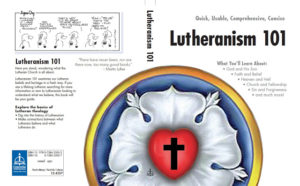Great Predictions of the End of the World as We Know It
Some Christians believe, despite what Jesus said about not being able to know when the Last Day will come (Matthew 24:36), that it is possible for someone to be able to predict either the day or at least the events that would lead to that great Last Day—the End of the World as We Know It [TEOTWAWKI]. Such predictions are not the exclusive property of bygone generations. Predictions of TEOTWAWKI and the events are still being talked about today. What follows here is a listing of only a few of the more well-known prophecies of TEOTWAWKI. The fact that you are reading this is ample witness that none have ever come true. Based upon past performance, there is ample witness that none have ever come true. Based upon past performance, there is every likelihood that the predictions of our day will not materialize either.
AD 992: Good Friday coincided with the Feast of the Annunciation; this had long been believed to be the event that would bring forth the Antichrist and thus the end-times events foretold in the Book of Revelation.
1000, January 1: Many Christians in Europe predicted the end of the world on this date. As the date approached, Christian armies waged was against some of the pagan countries in Northern Europe. The motivation was to convert them all to Christianity, by force if necessary, before Christ returned in the year 1000.
 1033: Some believed this to be the thousandth anniversary of the death and resurrection of Jesus. His second coming was anticipated in this millennial reckoning. Jesus’ actual date of crucifixion is unknown but is believed to be between AD 27 and 33.
1033: Some believed this to be the thousandth anniversary of the death and resurrection of Jesus. His second coming was anticipated in this millennial reckoning. Jesus’ actual date of crucifixion is unknown but is believed to be between AD 27 and 33.
1496: Said to be fifteen hundred years after the birth of Jesus, some fifteenth-century mystics predicted that the millennium would begin during this year.
1794: Charles Wesley, one of the founders of Methodism, predicted the end of the world would come in this year.
1843, March 21: William Miller, founder of the Millerite movement, predicted that Jesus would come on this date. A large number of Christians accepted his prophecy. When Jesus did not return, Miller revised his date to October 22, 1844.
1850-1856: Ellen White, founder of the Seventh-day Adventist movement, made many predictions of the timing of the end of the world.
1874, 1914, 1925, 1932, 1941, 1975, etc.: The Watchtower Society (Jehovah’s Witnesses) has made many predictions of the end of the world since its founding in the 1870s. Prior to 1975, they predicted the end would occur in subsequent future dates; most notably they said that Christ arrived secretly in 1874 and would establish the kingdom of God on earth in October 1914. It was predicted that in 1925 Abraham, Isaac, Jacob, and other faithful prophets would return as a sign of the beginning of the new order; then that Christendom would be overthrown in 1932; followed by the prediction that in the fall of 1941 the world was in the last months before Armageddon; and then that 1975 was a promising year for the end of the world because of a supposed six-thousandth anniversary of the creation of Adam and Eve. Obviously, all these dates came and went uneventfully. Since 1975, the Watchtower Society’s predictions have been much less specific. Despite their failure in the past, the Watchtower Society still expects that the end may happen at any time in our immediate future. In December 1995, Newsweek quoted Witness spokesperson Bob Pevy as saying, “The end is still close. We just can’t put numbers on Jesus’ words.” And with that, they ultimately get it right [Kenneth Woodward, “Jehovah’s Witnesses Decide the End is Fluid,” Newsweek, December 18, 1995].
1919, December 17: Meteorologist Albert Porta predicted that the conjunction of six planets on this date would generate a magnetic current that would cause the sun to explode and engulf the earth.
1936: Founder of the Worldwide Church of God, Herbert W. Armstrong, predicted that the Day of the Lord would happen sometime in 1936. When that prediction failed, he made a new prediction: 1975.
1948: Israel declared independence on May 14. Some Christians believed that this event was the final prerequisite for the second coming of Jesus.
1959, April 22: Leader of the Branch Davidian cult, Florence Houteff, prophesied that the 1,260 days mentioned in Revelation 11:3 would end and the Kingdom of David would be established on this day. Followers, expecting to die, to be resurrected, and to be transferred to heaven, sold their possessions and moved to Mt. Carmel. Texas, in anticipation of the end times. The failed prediction almost undid the group, and afterward only a few dozen members remained. However, seventy-six Branch Davidians did die on April 29, 1993, as a result of arson apparently ordered by their leader, David Koresh.
1962, October 15-28: Deemed the closest the world has ever come to nuclear war, the Cuban missile crisis spawned many predictions of the world’s end.
1967: Israel again. During the Six-Day War, June 5-10, the Israeli army captured all of Jerusalem. Many Christians believed that the rapture would quickly occur. However, the supposed final biblical prerequisite for the second coming is that the Jews would resume ritual animal sacrifices in the temple at Jerusalem; that has not yet happened (they now say).
 1970s: Moses David (aka David Berg), founder of the cult of the Children of God {later known as the Family International and the Family), predicted that a comet would hit the earth, probably in the mid-1970s, and destroy all life in the United States.
1970s: Moses David (aka David Berg), founder of the cult of the Children of God {later known as the Family International and the Family), predicted that a comet would hit the earth, probably in the mid-1970s, and destroy all life in the United States.
1970: Hal Lindsey’s best-selling book The Late Great Planet Earth, postulated that the then-current events would lead to a rapture of believers, tribulation, and second coming of Christ, which might play out in the 1980s. Lindsey later said that the “decade of the 1980s could very well be the last decade of history as we know it” (The 1980s Countdown to Armageddon [New York: Bantam Books, 1983]).
1978: Chuck Smith, pastor of Calvary Chapel in Costa Mesa, California, predicted the rapture in 1981.
1981: Rev. Sun Myung Moon, founder of the Unification Church, predicted that the kingdom of heaven would be established this year.
1982: Pat Robertson predicted a few years in advance that the world would end in the fall of 1982.
1990, April 23: At least two thousand members of the Church Universal and Triumphant quit their jobs, amassed large debts, and traveled to Montana to take refuge in the CUT’s fallout shelters after leader Elizabeth Clare Prophet predicted the start of nuclear war on this date. Later, church officials said the event was a drill.
1993, November 11: The July 20, 1993, issue of the Weekly World News contained an article titled “Doomsday Asteroids,” in which “top scientists” allegedly wrote a top-secret document revealing that asteroid M-167 would hit the earth on November 11 and end all life. In the M series of astronomical objects, there is no object with a number higher than M-110.
1996, October 23: Since 1658, the calculations of James Ussher have been accepted by some Christians as a date for the end of the world. Ussher’s calculations used millennial dating based on his theory that creation occurred on October 23, 4004 BC, and that 1996, the six-thousandth anniversary of creation, would usher in the end.
1997, March 26: Thirty-nine members of the Heaven’s Gate cult were discovered to have committed suicide in order to evacuate Earth prior to its recycling. The Heaven’s Gate members believe that a UFO traveling in the tail of the comet Hale-Bopp would take them to another level of existence above human.
1997, December 31: The July 29. 1997 issue of Weekly World News reported that a confidential Pentagon memo had been circulating in Washington and that President Clinton had called a secret meeting of Bible scholars on July 27. The memo outlined the details of cataclysmic worldwide events that would culminate in the shifting of the earth’s crust on the last day of the year.
 2000: There was widespread talk, among both the religious and the irreligious, that the world would end. The fact that it did not sent many experts back to the drawing board. Among the many predictions were those connected to the Y2K bug. It was thought that the resulting worldwide electronic failure would trigger global economic disaster and bring on the Antichrist.
2000: There was widespread talk, among both the religious and the irreligious, that the world would end. The fact that it did not sent many experts back to the drawing board. Among the many predictions were those connected to the Y2K bug. It was thought that the resulting worldwide electronic failure would trigger global economic disaster and bring on the Antichrist.
2001: Jack Van Impe Ministries broadcast a program dedicated to laying out Van Impe’s end-time prophecies detailed in his book On the Edge of Eternity. He said 2001 would see a beginning of global chaos that would lead to the seven-year period of tribulation, the Battle of Armageddon, and the second coming of Christ. Van Impe has since changed his predictions to sometime in the future.
2006, June 6: Some believed that the number of the beast, “666,” was really the date 06/06/06 and thus the start of the tribulation.
2006, July: Escalation of tensions in Lebanon led some Christian leaders to predict that the end of the world had already begun.
2011, May 21: Family Radio host Harold Campi9ng spread the word that this day would be the End of Days, that is, Judgment Day.
2012, December 21: The arrival of the winter solstice on this day was predicted to be the triggering event that would end the world as we know it. Many of these predictions were based on the calendar developed by the ancient Mayans, with this date supposedly being the last day to appear on the calendar.
2014. February 22: A horn blown on November 15, 2013, heralded the end of the world in 100 days, according to ancient Viking belief. The sound of the horn was supposed to have called the sons of Odin to the battlefield, where Odin would ultimately be killed, inaugurating the Viking apocalypse, also known as “Ragnarok.”
2015, September 28: The Blood Moon Prophecy is an idea popularized by Christian pastors John Hagee and Mark Biltz, which states that an ongoing tetrad (a series of four consecutive total lunar eclipses—or blood moons), which began with the April 2014 lunar eclipse, is a sign of the end times.
Predictions for the Not-Too-Distant Future:
2018: Having got it wrong in the 1970s, ‘80s, and again in 2007, Hal Lindsey predicts the second coming of Christ will occur in 2018. It seems he’s hedged his bet this time, as he has also identified 2037 for the coming of Christ.
 2020: The alleged psychic Jeane Dixon claimed that Armageddon would take place in 2020 and that Jesus would return between 2020 and 2037. Dixon previously predicted the world would end on February 4, 1962, and in 1968 predicted that Fidel Castro’s days were numbered (Castro eventually did die, as we all must, but it took 48 more years. He died 11-25-16 at the age of 90).
2020: The alleged psychic Jeane Dixon claimed that Armageddon would take place in 2020 and that Jesus would return between 2020 and 2037. Dixon previously predicted the world would end on February 4, 1962, and in 1968 predicted that Fidel Castro’s days were numbered (Castro eventually did die, as we all must, but it took 48 more years. He died 11-25-16 at the age of 90).
2020s or 2030s: In the April 2000 issue of Wired Magazine, Sun Microsystems cofounder and chief scientist Bill Joy predicted the end of humanity within twenty or thirty years. He wrote that leading-edge technologies such as robotics, genetic engineering, and nanotechnology may soon lead to the extinction of human society.
General Editor Kinnaman, Scot Lutheranism 101 (slightly altered) 63-67
I’ve said it before, and I’ll say it again, ANY TIME someone gives you a date for the Second Coming of Jesus you can just tune them out. They are contemporary examples of what the Old Testament called False Prophets. I might also point out that, while the above list focuses mainly on religious predictions of TEOTWAWKI, there are plenty that come from none-religious sources. Not only do such ideas make for exciting movies, but the fear generated by such notions motivates a lot of legislation in the United States and around the world. Christ wants us to live in faith, not fear; in hope, not terror; in joy, not panic.
